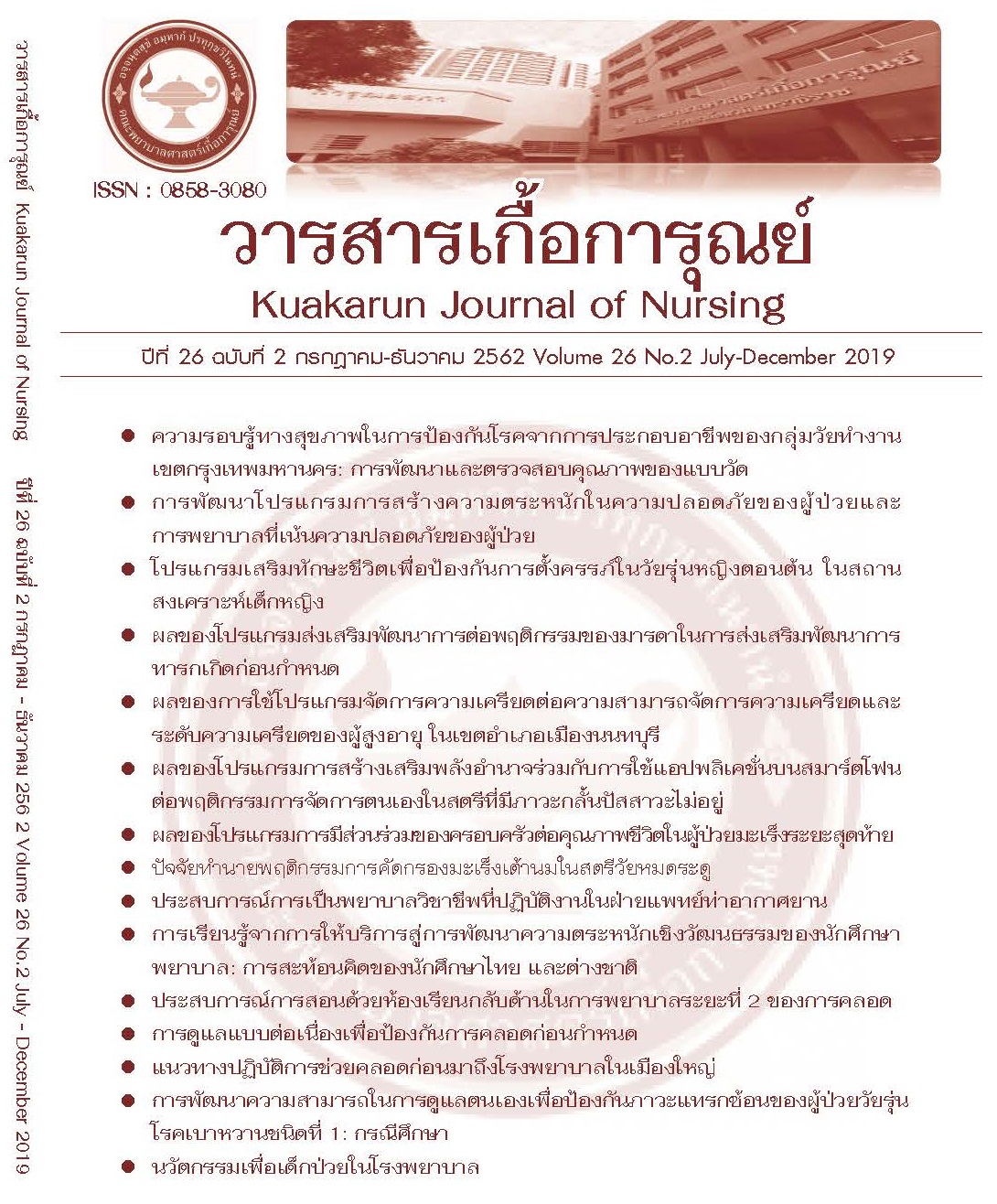ผลของโปรแกรมการสร้างเสริมพลังอำนาจร่วมกับการใช้แอพพลิเคชันบนสมาร์ทโฟนต่อพฤติกรรมการจัดการตนเองในสตรีที่มีภาวะกลั้นปัสสาวะไม่อยู่
คำสำคัญ:
การสร้างเสริมพลังอำนาจ, แอปพลิเคชันบนสมาร์ตโฟน, พฤติกรรมการจัดการตนเอง, ภาวะกลั้นปัสสาวะไม่อยู่บทคัดย่อ
การวิจัยครั้งนี้เป็นการวิจัยกึ่งทดลองมีวัตถุประสงค์เพื่อเปรียบเทียบพฤติกรรมการจัดการตนเองในสตรีที่มีภาวะกลั้นปัสสาวะไม่อยู่ก่อนและหลังได้รับโปรแกรมการสร้างเสริมพลังอำนาจร่วมกับการใช้ แอปพลิเคชันบนสมาร์ตโฟนและเปรียบเทียบพฤติกรรมการจัดการตนเองในสตรีที่มีภาวะกลั้นปัสสาวะไม่อยู่ ระหว่างกลุ่มที่ได้รับโปรแกรมการสร้างเสริมพลังอำนาจร่วมกับการใช้แอปพลิเคชันบนสมาร์ตโฟนกับกลุ่มที่ได้รับการดูแลตามปกติกลุ่มตัวอย่าง คือ สตรีที่มีอายุ 50 ปีขึ้นไปที่มีภาวะกลั้นปัสสาวะไม่อยู่ และมารับบริการตรวจ ณ ห้องตรวจศัลยกรรม คณะแพทยศาสตร์วชิรพยาบาล คัดเลือกกลุ่มตัวอย่างแบบเจาะจง จำนวน 60 คน จับฉลากแบ่งเข้าเป็นกลุ่มทดลอง 30 คน และกลุ่มควบคุม 30 คน โดยคำนึงถึงความคล้ายคลึงกันในเรื่อง อายุ สถานภาพสมรส ระดับการศึกษา และระดับความรุนแรงของภาวะกลั้นปัสสาวะไม่อยู่ กลุ่มควบคุมได้รับการดูแลตามปกติ กลุ่มทดลองได้รับการดูแลตามปกติและโปรแกรมการสร้างเสริมพลังอำนาจร่วมกับการใช้แอปพลิเคชันบนสมาร์ตโฟน เครื่องมือที่ใช้ในการวิจัย คือ โปรแกรมการสร้างเสริมพลังอำนาจร่วมกับการใช้แอปพลิเคชันบนสมาร์ตโฟน เครื่องมือที่ใช้ในการเก็บรวบรวมข้อมูล ได้แก่ แบบสอบถามข้อมูลส่วนบุคคล แบบประเมินความรุนแรงของภาวะกลั้นปัสสาวะไม่อยู่ และแบบสอบถามพฤติกรรมการจัดการตนเองในสตรีที่มีภาวะกลั้นปัสสาวะไม่อยู่ ซึ่งแบบสอบถามพฤติกรรมการจัดการตนเองฯ มีค่าความเชื่อมั่น สัมประสิทธ์แอลฟา ของครอนบาคเท่ากับ .81 สถิติที่ใช้ในการวิเคราะห์ข้อมูล ได้แก่ ความถี่ ร้อยละ ค่าเฉลี่ย ส่วนเบี่ยงเบนมาตรฐาน การทดสอบไคสแควร์ และสถิติการทดสอบค่าที
ผลการวิจัยพบว่า สตรีที่มีภาวะกลั้นปัสสาวะไม่อยู่ หลังจากเข้าร่วมโปรแกรมฯ มีค่าเฉลี่ยพฤติกรรมการจัดการตนเองเกี่ยวกับภาวะกลั้นปัสสาวะไม่อยู่สูงกว่าก่อนเข้าร่วมโปรแกรมฯอย่างมีนัยสำคัญทางสถิติที่ระดับน้อยกว่า 0.001 และมีค่าเฉลี่ยพฤติกรรมการจัดการตนเองเกี่ยวกับภาวะกลั้นปัสสาวะไม่อยู่สูงกว่ากลุ่มที่ได้รับการดูแลตามปกติอย่างมีนัยสำคัญทางสถิติที่ระดับน้อยกว่า 0.001 ผลการวิจัยนี้สามารถนำไปใช้เป็นแนวทางการพยาบาลเพื่อส่งเสริมพฤติกรรมการจัดการตนเองในสตรีที่มีภาวะกลั้นปัสสาวะไม่อยู่ได้ ควรมีการศึกษาในกลุ่มที่มีโรคเรื้อรัง เช่น เบาหวาน และภาวะผิดปกติของระบบทางเดินปัสสาวะ หรือกลุ่มที่ได้รับยาซึ่งเป็นปัจจัยเสี่ยงต่อการเกิดภาวะกลั้นปัสสาวะไม่อยู่ และส่งเสริมให้ครอบครัวหรือชุมชนเข้ามามีส่วนร่วมในการดูแลเพื่อการจัดการกับภาวะกลั้นปัสสาวะไม่อยู่
เอกสารอ้างอิง
คณะพยาบาลศาสตร์ มหาวิทยาลัยเชียงใหม่. (2557). คู่มือการฝึกปฏิบัติการพยาบาลผู้สูงอายุขั้นสูง. สืบค้น เมื่อเมษายน, 2561, 20, จาก file:///C:/Users/GG/Downloads/
งานเวชระเบียนและสถิติ คณะแพทยศาสตร์วชิรพยาบาล. (2560). สถิติผู้สูงอายุที่มีภาวะกลั้นปัสสาวะไม่อยู่ห้องตรวจศัลยกรรม. กรุงเทพฯ: คณะแพทยศาสตร์วชิรพยาบาล.
จันทนา รณฤทธิวิชัย, รัชนี ศุจิจันทรรัตน์, สมจินต์ เพชรพันธุ์ศรี, ถนอมขวัญ ทวีบูรณ์, พิชัย ศุจิจันทรรัตน์, และนิตยา มีหาดทราย. (2556). ผลของรูปแบบการจัดการอาการต่อระยะเวลาการกลั้นปัสสาวะไม่อยู่ในผู้สูงอายุสตรี. วารสารพยาบาลศาสตร์, 31(2), 7-15.
บุญใจ ศรีสถิตย์นรากูร. (2553). ระเบียบวิธีการวิจัยทางพยาบาลศาสตร์. กรุงเทพฯ: ยูแอนด์ไออินเตอร์มีเดีย.
รุจิราพร ป้องเกิด และทัศนา ชูวรรธนะปกรณ์. (2559). ผลของการเสริมสร้างพลังอำนาจต่อพฤติกรรมการดูแลตนเองของผู้สูงอายุโรคไตเรื้อรังที่ได้รับการรักษาด้วยการล้างไตทางช่องท้องอย่างต่อเนื่อง. วารสารเกื้อการุณย์, 23(2), 165-182.
ระพีพัฒน์ ธนะพัฒน์, พันทวี สัณฑิฐิเจริญวงศ์, พัสตราภรณ์ ภูกำพล, กิติรดา หร่ำรัศมี และชมพร แววโนรี. (2556). แนวโน้มการใช้งานสมาร์ทโฟนประเทศไทย. สืบค้นเมื่อเมษายน, 2561, 20, จาก https://sites.google.com/a/bumail.net/smartphones-lifestyle/
ละมัยพร โลหิตโยธิน, ขวัญจิต รังสฤษฏ์วีระโชติ และรดิวันต์ กิตติชัยเศรษฐ์. (2559). การพัฒนาโปรแกรมการเสริมสร้างพลังอำนาจในผู้ป่วยโรคหลอดเลือดสมองที่มีภาวะกลั้นปัสสาวะไม่อยู่. วารสารกรมการแพทย์, 41(3), 102-111.
ลออง ผดุ้งกูล และศรีพงา มัณฑางกูร. (2560). การจัดการกับภาวะกลั้นปัสสาวะไม่อยู่ และการรับรู้คุณภาพชีวิตของผู้รับบริการหญิงที่คลินิกนรีเวช. วารสารพยาบาลสงขลานครินทร์, 37(1), 75-83.
สำนักพัฒนาสุขภาพจิต กรมสุขภาพจิต กระทรวงสาธารณสุข. (2550). คู่มือการให้การปรึกษาผู้ติดเชื้อเอชไอวี/ผู้ป่วยเอดส์. นนทบุรี: บียอนด์ พับลิสชิ่ง.
สุภาพ ไทยแท้. (2555). ผลของโปรแกรมการเสริมสร้างพลังอำนาจต่อความสามารถในการดูแลตนเองและการดูแลบุตรของมารดาหลังคลอดที่ติดเชื้อเอชไอวี. วารสารพยาบาลสาธารณสุข, 25(3), 49-63.
อรพรรณ ฟูมณีโชติ และพิชญา พรรคทองสุข. (2560). ความชุกของภาวะกลั้นปัสสาวะไม่อยู่ในผู้สูงอายุในชุมชนเทศบาลเมืองบ้านพรุ อำเภอหาดใหญ่ จังหวัดสงขลา. สงขลานครินทร์เวชสาร, 35(2), 133-138.
Anshari, M., & Almunawar, M. N. (2016). Mobile health (mHealth) services and online health educators. Biomedical Informatics Insights, 8, 19-27.
Asklund, I., Samuelsson, E., Hamberg, K., Umefjord, G., & Sjostrom, M. (2019). User experience of an app-based treatment for stress urinary incontinence: Qualitative interview study. Journal of Medical Internet Research, 21(3), e11296.
Gibson, C. H. (1991). A concept analysis of empowerment. Journal of Advanced Nursing,16(3), 354-361.
Gibson, C. H. (1995). The process of empowerment in mothers of chronically ill children. Journal of Advanced Nursing, 21(6), 1201-1210.
Hoffman, V., Soderstrom, L., & Samuelsson, E. (2017). Self-management of stress urinary incontinence via a mobile app: Two-year follow-up of a randomized controlled trial. Acta Obstetricia et Gynecologica Scandinavica, 96(10), 1180-1187.
Lasserre, A., Pelat, C., Guéroult, V., Hanslik, T., Chartier-Kastler, E., Blanchon, T., … Bloch J. (2009). Urinary incontinence in French women: Prevalence, risk factors, and impact on quality of life. European Urology, 56(1), 177-183.
Minassian, V. A., Devore, E., Hagan, K., & Grodstein, F. (2013). Severity of urinary incontinence and effect on quality of life in women by incontinence type. Obstetrics & Gynecology, 121(5), 1083-1090.
Polit, D., & Beck, C. T. (2012). Nursing research: Generating and assessing evidence for nursing practice (9th ed.). Philadelphia, PA: Lippincott Williams and Wilkins.Ramage-Morin, P. L. (2013). Urinary incontinence and loneliness in Canadian seniors. Health Reports, 24(10), 3-10.
Schimpf, M. O., Patel, M., O’ Sullivan, D. M., & Tulikangas, P. K. (2009). Difference in quality of life in women with urge urinary incontinence compared to women with stress urinary incontinence. International Urogynecology Journal, 20(7), 78-89. doi: 10.1007/s00192-009-0855-4
Vasavada, S. P. (2014). Epidemiology. Urinary Incontinence. Retrieve July, 2019, 28, from https://emedicine.medscape.com/article/452289-overview#a6.
Wattanayingcharoenchai, R., Manonai, J., Vannatim, N., & Saritapirak, S. (2007). Impact of stress urinary incontinence and overactive bladder on quality of life in Thai women attending the urogynecology clinic. Journal of the Medical Association of Thailand, 90(1), 26-31.
Wyman, J. F. (1999). Urinary Incontinence. In J. T. Stone, J. F. Wyman, & S. A. Salisbury (Eds.), Clinical erontological nursing: A guide to advanced practice (2nd ed, pp. 203-231). Philadelphia: W.B. Saunders.















